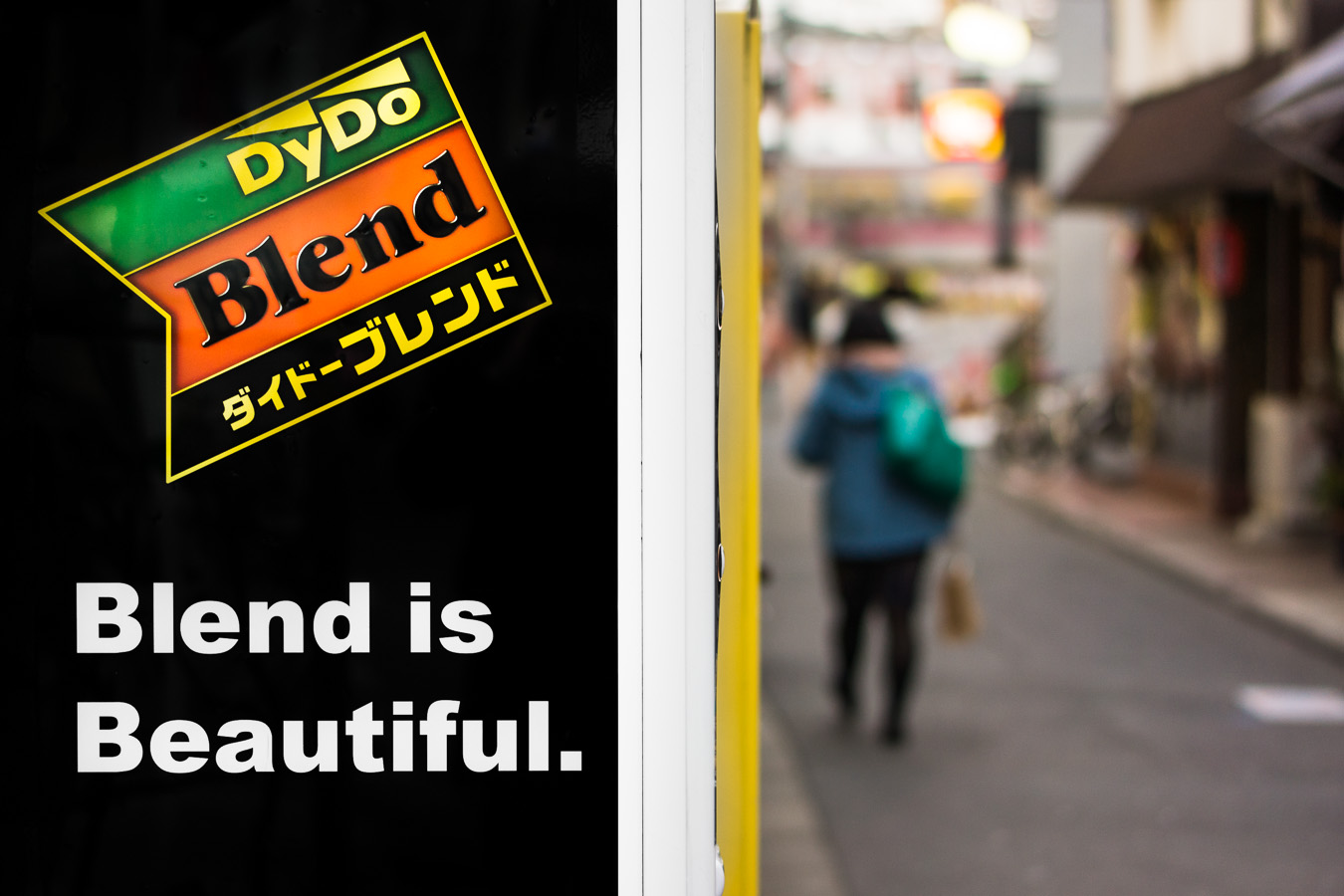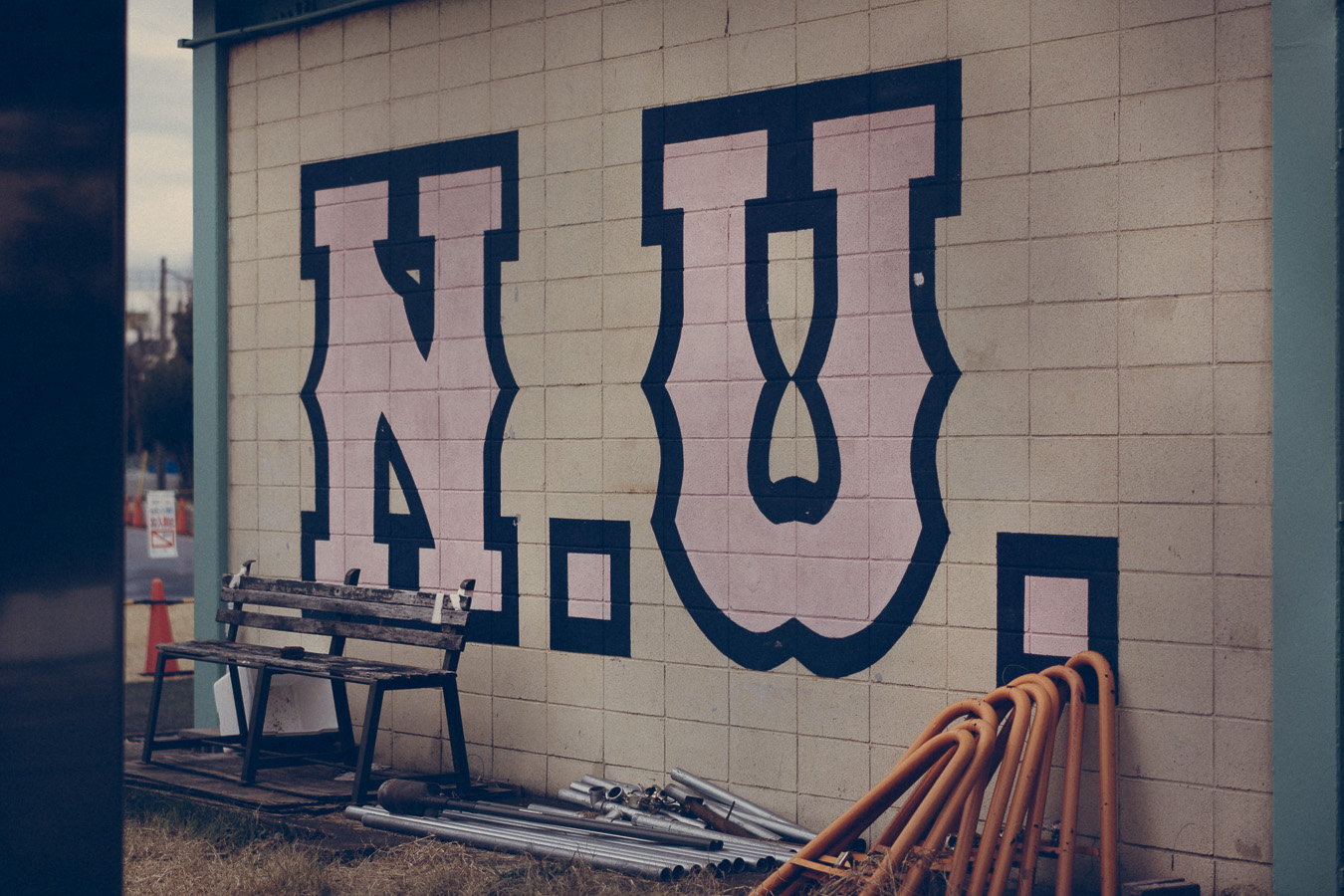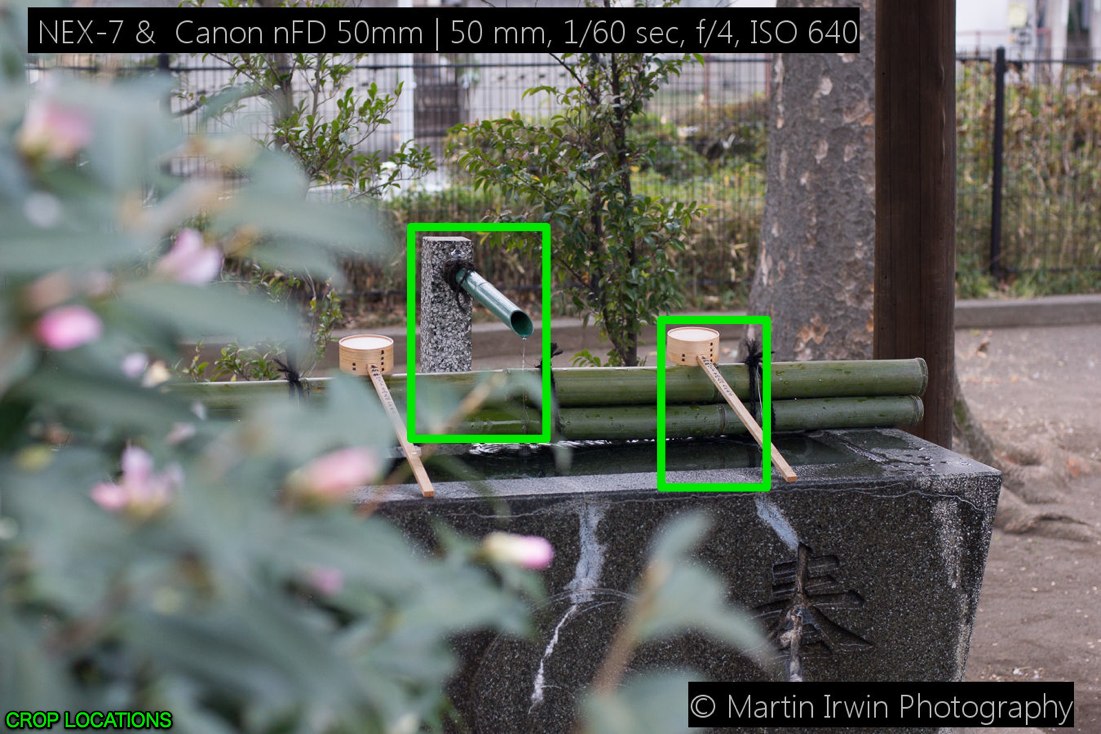I couldn't help but think of the never-ending "battle of the sensor sizes" between camera manufacturers when I saw this structure.
Blog
Pipe
The gap in the fence was just large enough to squeeze the lens through! I liked the obvious ageing in this scene, from the rusty pipe to the obviously draughty windows. The curtains look like something from 1980, and probably are.
I also liked the difference grid sizes offered by the shadow of the fence across the objects near and far.
My friend Zaq
I don't think that this advertising ploy had any effect on these little girls, other than a few moments of happiness. I felt sorry for the person inside, though they're probably keeping warmer than we were. I was debating taking a video - the little girls were running around and around, giggling, whilst the mascot bobbed up and down and waved its arms.
Only in Japan.
J:COM, Jupiter Telecommunications Co., Ltd, is the largest provider of digital television and broadband internet in Japan, and this little guy is its brain child.
Never appearing alone, ZAQ is actually a species of little egg-headed beings who inhabit everyday appliances around the house, creeping out every so often to convince residents that they need faster Internet connections and more channels.
Created in 2003, he was modeled after the forest sprites found in the beloved Ghibli filmPrincess Mononoke. ZAQ is obviously the three leftmost keys on a QWERTY keyboard making his name easy to type, and the letters stand for Zone Access & Quality.
More recently, it has been translated into Japanese as Zutto, Anshin, Quality, meaning “Always, Safety, Quality.”
Representing your area
These political posters end up in the most unflattering of places.
Asakusa
I've been to Asakusa 「浅草」 many times over the years, but I've not been back here for around a year or so. The temple of Sensoji 「浅草寺」is a very popular all-year tourist attraction, and basically, I try to avoid those.
The area is, however, rather photogenic. As it'd been so long, and there's something about New Year and temples, we decided to take the hour-long journey from our place in west Tokyo, to the eastern side. In order to do so, one heads for the HDTV beacon known as Tokyo Sky Tree.
Satellite TV
Going to work
It's traditional to waft the smoke from the incense over one's head
The temples are full of thousands of little details - almost too many to take in. Fighting my way through groups taking "selfies", I once more made use of my considerable height advantage.
Plane, moon, temple
I find it rather amusing when I stop to take a photograph, because I've seen something, and a small group will gather around me, phones, cameras, and iPads (?) at the ready. The people try to understand exactly what I'm looking at, but perhaps it's nothing in particular, and just a certain light or reflection which has piqued my interest. I've even gone as far to fake seeing something interesting, for my own amusement :)
Sonnar 2/35
It's raining a lot here in Tokyo (and Kyoto, apparently - you know who you are!), and so I decided to take a quick macro shot of my DSC-RX1.
The Zeiss Sonnar is a photographic lens originally designed by Dr. Ludwig Bertele in 1929 and patented by Zeiss Ikon. It was notable for its relatively light weight, simple design and fast aperture.
It's an amazing lens, and sensor, and I am not sure why I would ever part with it. As point and shoot cameras go, I don't think there is a better one than this. It's arguably Sony's best ever camera.
Stretching My Legs
I went for a little stroll at lunchtime; in the winter months it's tempting to stay inside and not expose oneself to the elements. This would work, if Japanese buildings had any kind of insulation whatsoever. Unless heaters are blazing all day (and even if they are), the rooms will lose heat quicker than you can say "Jack Frost".
This means that it can actually be warmer outside, in the direct sun, than inside. Nuts. Of course, the opposite is true in the summer - it's impossible to cool down.
After stretching my legs, it was time to get back to the office and get back to work.
This way!
NEX-7 & SEL55F18Z | 1/100s f/1.8 ISO250 55mm
Blend is Beautiful
I agree with the above coffee advert - blend is beautiful. This sentiment is valid for certain aspects of photography, too. Often, it is desirable to have a very smooth blend of background blur, or bokeh (the Japanese word for blur).
Making sure that the building site isn't too loud
In the pursuit of the perfect blend, I've acquired Sony's latest FE-mount lens, the SEL55F18Z. As pointed out by friend and fellow photoblographer Björn Utpott (his blog is a source of daily inspiration), I have a lens with a similar focal length and aperture already - the Canon nFD 50mm F1.4.
Even though the weather today was completely overcast, I took both lenses with me on the way to the shops and performed something of a comparison.
This isn't a scientific test by any interpretation, but one thing is clear - the new FE 55/1,8 is very sharp wide open, and does not have any purple fringing, or suffer from chromatic aberration (CA). When the nFD lens is stopped down to f/4, the image is very sharp. The new Sony FE lens is sharper, but this may not matter to some. I would still recommend the nFD lens to those on a budget, or wanting to use manual focus glass... but I would recommend the new Sony FE 55/1,8 Zeiss lens over it... every time.
Incidentally, you may (or more likely, may not) have noticed a change to the homepage of this site. I hope you like it! I've also changed the "reviews and gear" section, listing my ramblings in reverse chronological order.
I hope that you enjoyed the photos, and found the (non-scientific) comparison interesting.
I made it just 2 days...
Well, I made it 2 whole days (though just 1 shopping day) into 2014 without buying a new lens... though this lens was no impulse buy. It's the new Sony FE (full-frame image circle E-mount) Zeiss Sonnar 55/1,8 lens (model name: SEL55F18Z ). This lens has an MTF curve out of this world (stellar light transmittance, essentially - Zeiss have a white paper on the topic). In practice, this means that the lens has extremely high resolution and contrast "wide open" at its maximum aperture (opening). Designing a lens like this is no mean feat - I've never seen a curve like it. The lens outputs an image circle covering the size of a full-frame sensor, like my RX1, but I am currently using the lens on my trusty NEX-7.
Is this my next camera? There's a full-frame sensor squeezed inside the miniscule Sony A7R.
After purchasing the lens in Akihabara, we decided to go for a walk and test out the new lens. What better way to test a lens and camera than at night? :)
It's probably a little early for a verdict, but overall, I'm very impressed. The high pixel density, cropped sensor (APS-C size) of the NEX-7 really tests the central zone of any lens.
Sometimes it's easy to forget we're in Tokyo
There is a 50/1.8 lens, with optical stabilisation, already available for Sony E-mount cameras. It's been around a couple of years. It's maybe 1/3rd the price of this lens, but only covers the APS-C image circle, and thus would not be useful on any future full-frame camera. Rather than sink my money into a lens I'll use (happily) until I "go full frame", I decided to spend that little bit more, and "future-proof" myself with a world-class lens.
And I have no regrets.
Ginza
I wanted to share a few photos I took whilst in Ginza, a rather up-market district in Tokyo.
It's a great place for car and people watching - it's the place to be if you like high prices and designer labels.
Remember to look up whilst walking around Ginza, and you'll be in for a treat - some of Tokyo's most interesting modern buildings are in Ginza.
Happy New Year!
明けましておめでとうございます!
Happy New Year!
We got on our bikes at around 11:15 and cycled to a nearby temple to join the New Year festivities. It was a very cold, but clear night here in Tokyo.
There were lots of stalls selling a variety of foods, drinks, and other festive gear (such as pikachu face-masks).
The crowds waited patiently at the front entrance to the temple
It's traditional to buy a fortune written on a strip of paper, called o-mikuji (御御籤). It's also traditional to tie the fortune to these ropes at the temple, so that the fortune may have greater effect.
Our fortunes, tied to rope at the temple
A Happy New Year to all that read (and will read) my blog over the coming year. I'll strive to develop my photography in as many ways as possible. Thanks for dropping by, and I wish you all the best for 2014!
Where's my wallet?
It's fashionable in Japan to keep one's wallet in one's back pocket - something my father told me never to do under any circumstances. I suppose that's the difference between Japan (even in a massive city such as Tokyo), and the West - street crime is so low here. I notice open bags, wallets half out of jeans, and handbags used to reserve tables in coffee shops, on an almost daily occurrence.
A side effect of Japan being so safe is that Japanese tourists are extremely vulnerable when abroad. I recall seeing the sign "pickpockets operate in this area" in the Japan Store in London, back in 2010, and thinking "wow, this place must be a hotbed for crime!". Upon closer reading, the sign meant London itself, and to keep your bags zipped up and valuables out of sight - something which I do without thinking.
I suppose the fact I actually notice this, shows that I haven't lost this part of my upbringing.




















